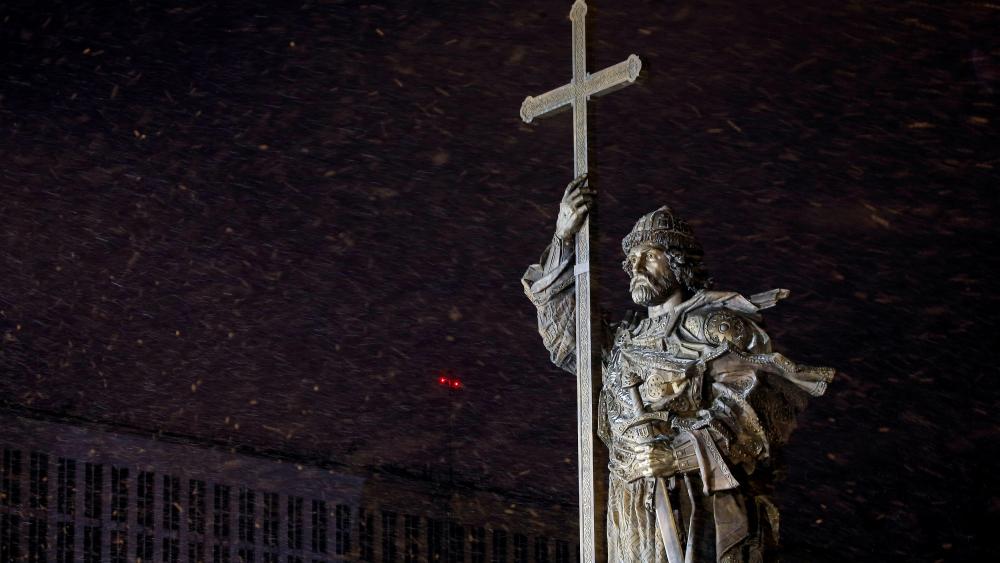Blog Post
The bloody Baptism of Russia
By Jonathon Van Maren
In Russia, everything seems to have a violent backstory. The Cathedral of Christ the Saviour, for example, was built in Moscow in 1883, the largest church in the vast Russian Empire—until Joseph Stalin, in his iconoclastic fervor, blew it up to make way for a proletarian public swimming pool. Accompanied by a friend and the journalist I was working with, we were headed to see the magnificent reconstruction of the cathedral, which cost over $170 million and was formally consecrated in 2000 by Patriarch Alexy II. As we made our way down the street, an enormous black figure loomed in my peripheral vision.
Just yards from the Kremlin walls on Borovitsky Hill and rising sixty feet over Moscow traffic was an enormous statue of a helmeted warrior in long robes, supporting an ornate cross that soared high above him in his right hand and a sheathed sword in his left. He resembled a bearded warrior-monk, and he stared fixedly and with a furrowed brow towards the church we were going to visit. The flag that indicated Putin was in his office flapped from the Kremlin just above him. I asked the journalist who the man was. “St. Vladimir,” she replied. “He brought Christianity to Russia.”
I wanted to learn more—this was the second time I’d heard of Vladimir since I arrived in Russia. The first time, an elderly woman sitting next to me on the train from St. Petersburg to Moscow had peered at my book, recognized it as Tolstoy’s Resurrection, and then interrupted my reading and proceeded to narrate the history of Christianity in Russia in broken but decipherable English, beginning with Vladimir. “He made us Christian,” she told me with an approving nod.
St. Vladimir, it turned out, is also known to history as Vladimir the Great, arriving on the scene in 958 AD as the youngest son of Sviatoslav I of Kiev. His mother was a housekeeper named Malusha, who according to Norse legend was a pagan prophetess who had the power to predict the future and lived to see her hundredth birthday—a strange mother for a son who would eventually bring Christianity by force to the embryonic Russian state, then known as Rus. Vladimir’s birthplace is a matter of contention: it was in either modern-day Volyn Oblast, Ukraine, or Pskov Oblast, Russia—there is an enormous statue of Vladimir in Kiev, as well, and the erection of the competing Moscow statue was seen by some as a provocation of Ukraine by Vladimir Putin.
The idea of Vladimir the Great becoming a saint would have appeared, early on, to be ridiculous. After the death of his father in 972, an internecine conflict broke out—Vladimir’s half-brother Yaropolk, ruler of Kiev, attacked a third brother, Oleg. Vladimir, who had been appointed the ruler of Novgorod the Great, was forced to flee to his relatives in Norway, but promptly returned with an army of Norse warriors. On his way to face Yaropolk in Kiev, Vladimir conquered the small city of Polotsk, forcing his brother’s fiancée Regneda to marry him against her will—a high-born princess, she had scorned him because his mother was a slave. Vladimir then lured Yaropolk out of Kiev with the promise of negotiations in 980, killed him, and thus became sole ruler of the Kievan Rus.
After establishing himself as the sole sovereign, Vladimir proved himself to be an exceptional military commander, taking territory from the Poles, the Latvians, the Volga Bulgars, and brutally suppressing all rebellions and insurgencies. As his power grew and he took new territory, Vladimir proved a strong supporter of paganism, building an enormous temple to six of the Slavic pagan gods, implementing human sacrifice, and setting up shrines and idols during his travels and military conquests. He had five wives and at least 800 concubines—one of whom was the imprisoned wife of his dead brother Yaropolk. Christianity was appearing in Russia slowly, but Vladimir showed not the slightest interest, far preferring the Norse gods of war and thunder to the sect of a crucified Jew.
It was Vladimir’s decision to unite the Kievan Rus into a territory under a single religion that changed everything. Initially, Christians were persecuted by those who took great offense to any perceived insult to the Slavic gods—the Orthodox Church considers the first Christian martyrs in Rus to be Theodore the Varangian and his son John. John was chosen by pagan priests for human sacrifice in what was apparently a rigged set of lots, and his father responded by scorning the gods of wood that “do not eat, nor drink, nor speak…I shall not give my son over to devils.” The exact details are lost to history, but the two were apparently murdered by an angry pagan crowd—and there is some indication that Vladimir was very impressed by their courage in the face of violent death.
The story of Vladimir’s decision to impose Christianity on the Rus is a bizarre one. According to some, he had decided on a monotheistic religion, which narrowed down the choices to Christianity, Islam, and Judaism. If Christianity was chosen, then he also had to decide whether the Catholic tradition or the Eastern Orthodox tradition was better (the Reformation being, at that point, more than five centuries in the future). Ambassadors from surrounding nations arrived to convince Vladimir of the truth of their traditions, and he carefully heard each one out. He rejected the Islam of the Volga Bulgars as too prohibitive, and Judaism as too weak. Catholicism did not suit the Russians, and so Vladimir eventually decided on Eastern Orthodoxy.
Vladimir was baptized in 988 after a military campaign in Byzantine where he demanded the hand of the sister of Emperors Basil II and Constantine VIII in marriage in exchange for his promise not to attack Constantinople—and the emperors agreed on the condition that Vladimir be baptized, sending their sister Anna to Vladimir with an escort of priests to carry out the task. Vladimir accepted baptism with his warriors, and then married Anna in a Christian wedding ceremony—there is no record of the attendant bishop bringing up the awkward topic of Vladimir’s previous wives and harem of hundreds.
The newly-wed Grand Prince of Kiev, ever a decisive commander, promptly went to work to introduce his people to his new religion. He had the pagan temples razed and the idols destroyed, and then had the citizens gather on the banks of the Dnieper River on September 1, 988. There, his people followed Vladimir’s lead and were baptized—the event, in Orthodox ecclesiastical history, is known as the Baptism of Russia. Novgorod, the first city ruled by Vladimir, pushed back against this sudden conversion and rebelled. The newly-baptized Vladimir responded as he always had and crushed the uprising with troops, thus cementing his role in history as the bloody Constantine of the Russian peoples.
***
As I traveled Russia, one unavoidable fact was driven home to me time and time again: The history of the Russian Orthodox Church and the history of the Russian nation cannot be disentangled. They are one in every imaginable way. From tragedies where crowds of people huddled in cathedrals for safety and triumphs where clergymen prayed over soldiers as they rode to battle, to warrior-monks who simultaneously became Orthodox saints and nationalist heroes—to the statue of a man named Vladimir who demanded the baptism of his people, dead over 1,000 years, causing a controversy over the policies of another man named Vladimir towards the Ukraine today–it is impossible to understand the one without the other.
In 1988, one Russian journalist told me as we chatted in a little basement café, the celebration of a thousand years of Christianity—the millennial anniversary of the Baptism of Russia—was held in Moscow. In a move that stunned many, the USSR permitted the celebration to become a state-wide event rather than simply a church one, a huge shift in policy for the Soviet Union—and an indication that the hairline cracks in the Communist regime were spreading. The simple fact that the Russian people would be permitted to celebrate the arrival of that hated faith in Russia by a Communist government that had attempted to douse the flame of faith with gallons of martyr blood was enormously significant.
Interestingly, of course, Christianity arrived in what would become Russia sometime before Vladimir the Great’s somewhat dubiously motivated attempt to hasten the Christianization of the Rus. In the misty years where history and legend merge with one another, tradition tells a story of the Apostle Andrew arriving on the northern shores of the Black Sea, visiting Scythian and Greek colonies—and then moving on to the place that would one day be Kiev. A grand cathedral, St. Andrew’s, was built on the spot where he purportedly preached to commemorate the visit of the “Apostle of Rus.”
Centuries later, Byzantine Greek missionaries began to translate the Bible into Old Church Slavonic, and some sources indicate that the first Christian bishop was sent to Novgorod from Constantinople in either 866 or 867. Thus, there were many Christians among the Russian peoples long before Vladimir the Great decided that it was a convenient way to unite his subjects—including, incidentally, his grandmother, Princess Olga of Kiev, who was one of the first major rulers to convert to Christianity. To commemorate these early beginnings, Prince Msytyslav of Halych built one of the original churches in 1215 that memorialized the visit of the Apostle Andrew, calling it the Church of the Exaltation of the Cross.
Like so much of Russia, however, that little church did not survive the smoldering devastation wreaked by savage warriors who came pounding across the steppe like devils on horseback: The Mongols.
***
For several hundred years, the Orthodox Church grew steadily despite the persistence of paganism and the occasional uprising, including a spasm of pagan violence in Novgorod in 1071 which threatened the life of a bishop and ended when Prince Gleb Sviatoslavich dispersed the mob by chopping a pagan sorcerer, presumably an instigator, in half with an axe. Under the careful care of the Patriarchate of Constantinople, the Kievan church began to transform into a sprawling institution that would eventually become the very soul of the Russian people—just as Vladimir the Great had envisioned.
And then in the 1220s the Mongols came, an event of such utter destruction that it is almost unfathomable, even today. As Ted Byfield put it in volume seven of his history of the Christians, A Glorious Disaster: “In England…the herring business all but collapsed when most buyers from the Baltic just never showed up. Why? It seemed that there suddenly were fewer people left in the Slavic lands to buy the catch—wiped out, some reported, by hideous horsemen appearing like a whirlwind from lands to the east…They usually left nothing alive, and in any case the stench of corpses made whole cities uninhabitable. The princes of the Slavic people, then known as the Rus, reportedly had assembled the greatest army in their history, but in a single battle…had [been] wiped out.”
It was true. In 1223, a Mongol army annihilated a Slavic army of 80,000 men led by the prince of Kiev—and that was merely the beginning. Genghis Khan’s death in 1227 provided no relief. His sons and his grandsons returned to push further and further into Russia, butchering entire populations, enslaving the girls, women, and young boys, and burning cities and settlements so thoroughly they were turned into black, rotting deserts. The clergy of Russian Christendom were not spared—nuns were raped, priests were forced to watch, and then all were burned alive. Only a few were spared to gasp out tales of horror to the populations of other cities so that they would know what awaited them. This carnage culminated in December of 1240, when the magnificent city of Kiev was levelled, and its population reduced to human rubble. Years later, travelers passing through would only find ruined streets littered with skulls and scattered bones.
And centuries after the Mongol Golden Horde was finally driven from Russian lands, the evils they perpetrated with such callousness and relish still linger here, a scar cut deep into the Russian psyche. A Russian Orthodox nun, chatting with us about the history of her Church, managed to mention several times the mass kidnapping and enslavement of Christian girls by Mongol warriors, the beautiful flowers of the steppe brutally harvested by cruel nomads. During our evening in the compound of a Russian Orthodox motorcycle gang, the Night Wolves, the biker we were interviewing also mentioned the enslaving of girls and women by the Mongols as he talked about his inspiration, a warrior-monk named Alexander Peresvet, who died in single combat with a Tatar champion.
In Russia, these things seem to be almost recent despite the long centuries that separate us from the plight of terrified girls torn from their homes, of young wives pulled sobbing from the corpses of their slain husbands by rough horsemen who carried them off into lands unknown, never to be seen again. It seems that when some men today (like the Russian biker who gruffly talked to us about the “duty to protect” from outside evils) see the pretty red-cheeked girls nearly entirely encased in fur walking about Moscow, they still see the Christian girls who were stolen from their homelands all those ages ago. Considering the fact that they are a people who are still upset about the Sacking of Constantinople in 1204, this shouldn’t have surprised me, but it did. Here, “the past is present” is not a cliché. It is the way people live.
Author’s note: Part II of my Russia series will appear next week.
________________________________
For anyone interested, my books: The Culture War, Seeing is Believing: Why Our Culture Must Face the Victims of Abortion, and How To Discuss Assisted Suicide, are available for sale here.








